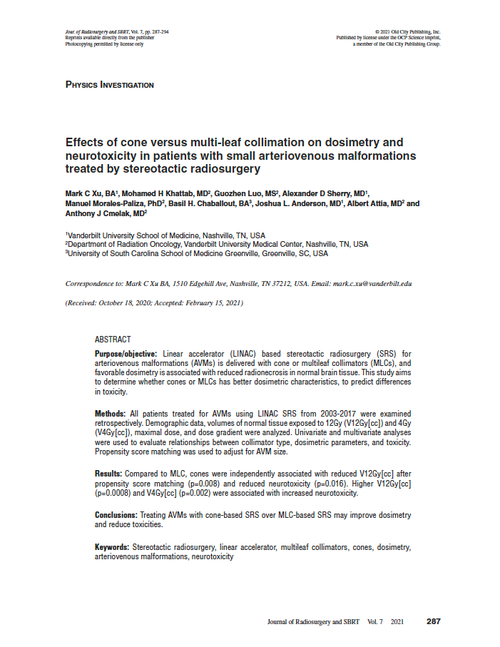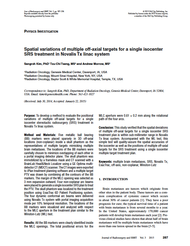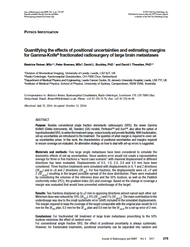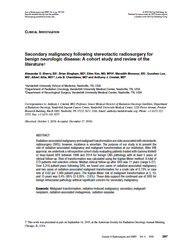- Home
- Journal Contents Downloads
- JRSBRT Downloads
- JRSBRT 7.4, p. 287-294
Product Description
Effects of cone versus multi-leaf collimation on dosimetry and neurotoxicity in patients with small arteriovenous malformations treated by stereotactic radiosurgery
Mark C Xu, Mohamed H Khattab, Guozhen Luo, Alexander D Sherry, Manuel Morales-Paliza, Basil H. Chaballout, Joshua L. Anderson, Albert Attia and Anthony J Cmelak
Purpose/objective: Linear accelerator (LINAC) based stereotactic radiosurgery (SRS) for arteriovenous malformations (AVMs) is delivered with cone or multileaf collimators (MLCs), and favorable dosimetry is associated with reduced radionecrosis in normal brain tissue. This study aims to determine whether cones or MLCs has better dosimetric characteristics, to predict differences in toxicity.
Methods: All patients treated for AVMs using LINAC SRS from 2003-2017 were examined retrospectively. Demographic data, volumes of normal tissue exposed to 12Gy (V12Gy[cc]) and 4Gy (V4Gy[cc]), maximal dose, and dose gradient were analyzed. Univariate and multivariate analyses were used to evaluate relationships between collimator type, dosimetric parameters, and toxicity. Propensity score matching was used to adjust for AVM size.
Results: Compared to MLC, cones were independently associated with reduced V12Gy[cc] after propensity score matching (p=0.008) and reduced neurotoxicity (p=0.016). Higher V12Gy[cc] (p=0.0008) and V4Gy[cc] (p=0.002) were associated with increased neurotoxicity.
Conclusions: Treating AVMs with cone-based SRS over MLC-based SRS may improve dosimetry and reduce toxicities.
Keywords: Stereotactic radiosurgery, linear accelerator, multileaf collimators, cones, dosimetry, arteriovenous malformations, neurotoxicity
After payment has been processed for your order of a digital copy (PDF) of this article, you will see a download link on your completed order page and also receive an email containing a download link. The links, which will enable you to download one copy of the article, will expire after 24 hours.
 Loading... Please wait...
Loading... Please wait...








